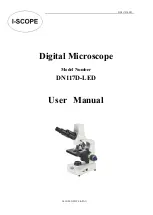
OPERATION
Axio Observer
Brightfield reflected light microscopy...
ZEISS
12/2016
431004-7244-001
103
5.5
Brightfield reflected light microscopy - quick guide
Before starting to work with the microscope, first read the sections 2, 3 and 4.
•
Prepare the microscope and switch it on in accordance with section 4 (Fig. 85/
17
).
•
Select the objective with the lowest magnification (e.g. 10x) on the nosepiece (Fig. 85/
5
). Set factor 1x
on the selector wheel (Fig. 85/
8
) of the Optovar turret (selector wheel only available on 5 and
5 materials stands).
•
Open the aperture diaphragm and luminous-field diaphragm completely; to do this, move the lever of
the sliders (Fig. 85/
2
,
3
) upwards to the mechanical stop.
•
Swivel in the reflector module
H
for bright field (or
DIC
) on the reflector turret (Fig. 85/
7
) using the
adjustment ring.
•
If required, remove analyzer slider (in Fig. 85/
18
) or switch to free light path.
•
Turn selector wheel for sideport right / left / vis (Fig. 85/
19
) to position 100 % vis (visual
).
•
Set beam splitting ratio to 100 % vis (Fig. 85/
12
) on the tube. Remove the Bertrand lens from the
optical path (where used). Move the rotary / sliding button (Fig. 85/
13
) to the 100 % vis position
(
).
•
Place a high-contrast specimen on the microscope stage (Fig. 85/
1
). Set the binocular section
14
).
•
Use the coarse / fine focus drive (Fig. 85/
9
) to
focus on the selected detail of the specimen.
Should no light be visible in the eyepieces,
switch on the microLED or HAL 100 illuminator
using the RL switch (Fig. 85/
10
).
•
Set the light intensity to a comfortable level
using the illumination control wheel
(Fig. 85/
11
).
•
Close luminous-field diaphragm (Fig. 85/
3
) until
it is visible (Fig. 84/
A
).
•
Use the focus drive (Fig. 85/
9
) to refocus on the edge of the luminous-field diaphragm (Fig. 84/
B
).
•
After this, center the luminous-field diaphragm by adjusting both adjusting screws in the slider
(Fig. 85/
3
; using a 3 mm ball-headed screwdriver) (Fig. 84/
C
). Then open the luminous-field diaphragm
until the edge of the diaphragm just disappears from the field of view (Fig. 84/
D
).
•
Remove one eyepiece from the eyepiece tube (or swing in Bertrand lens) and set aperture diaphragm
(Fig. 85/
2
) to approx. 70-80% of the diameter of the objective exit pupil (Fig. 84/
E
). The settings
required for optimum contrast depend on the specimen.
•
Insert the eyepiece again (or swing out Bertrand lens) and refocus, if required, via the fine drive.
•
After the microscope has been set to reflected light brightfield in this way, you can now change to the
specific contrasting technique (see section 5.12).
If the fully motorized Axio Observer 7 materials stand is used, the motorized components can
be operated using the TFT touchscreen display or other buttons (see section 5.11).
Fig. 84
Diaphragm settings in reflected
light bright field acc. to KÖHLER
Summary of Contents for Axio Observer Series
Page 1: ...Axio Observer Inverted microscope Operating manual...
Page 192: ......
















































